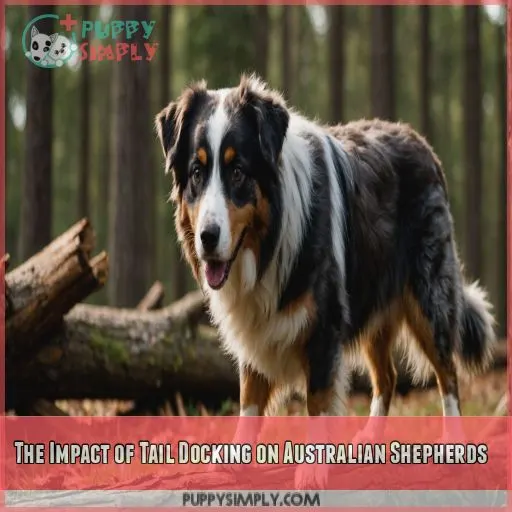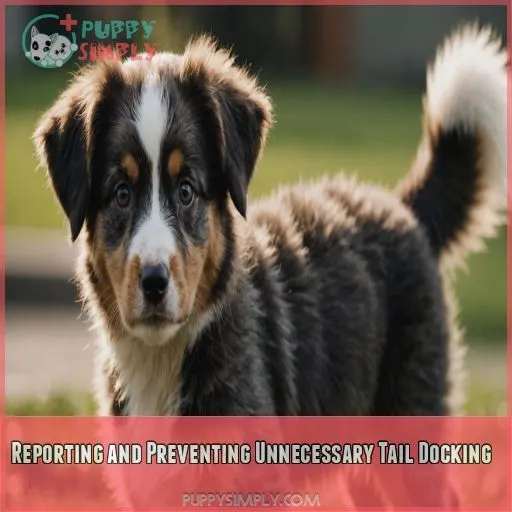This site is supported by our readers. We may earn a commission, at no cost to you, if you purchase through links.

Honestly, it’s a topic that’s sparked heated debates.
Initially, tail docking was done to prevent injuries in herding dogs, but now many argue it’s an unnecessary and painful procedure.
The American Veterinary Medical Association strongly opposes tail docking for non-therapeutic reasons, citing risks and unnecessary pain.
As a responsible dog owner, you want to make informed decisions about your furry friend’s welfare.
So, what’s the real deal behind Australian Shepherd tail docking?
Let’s get to the bottom of it and explore the shocking truth that’s changing the game.
Table Of Contents
- Key Takeaways
- Australian Shepherd Tail Docking Debate
- Risks and Complications of Tail Docking
- Why Australian Shepherds’ Tails Are Docked
- The Impact of Tail Docking on Australian Shepherds
- Alternatives to Tail Docking for Australian Shepherds
- The Future of Tail Docking in Australian Shepherds
- Reporting and Preventing Unnecessary Tail Docking
- Frequently Asked Questions (FAQs)
- Should Australian Shepherds tails be docked?
- What percentage of Australian Shepherds are born without tails?
- Is tail docking abusive?
- Why are Aussie tails docked on Reddit?
- Is tail docking necessary for working Australian Shepherds?
- Can tail docking affect an Australian Shepherds balance?
- How does tail docking impact Australian Shepherd insurance costs?
- Are there breeders who refuse to dock Australian Shepherd tails?
- Can I still show my Australian Shepherd with a natural tail?
- Conclusion
Key Takeaways
- You’re probably aware that Australian Shepherd tail docking is a contentious issue, and for good reason—it can cause unnecessary pain, infection, and nerve damage, which is why the American Veterinary Medical Association strongly opposes it.
- When you dock your Australian Shepherd’s tail, you’re not only putting them at risk for complications, but also affecting their ability to communicate with other dogs and even with you, which can lead to behavioral issues like aggression and anxiety.
- Many breeders and owners are now choosing to leave their Australian Shepherds’ tails intact, embracing their natural appearance and promoting a more compassionate approach to breeding—and you can join them by supporting responsible breeders and spreading awareness about dog welfare.
- By choosing not to dock your Australian Shepherd’s tail, you’re not only prioritizing their welfare, but also contributing to a growing movement that values animal welfare over aesthetics—and that’s a pretty great thing to be a part of.
Australian Shepherd Tail Docking Debate
You’re probably wondering why Australian Shepherd tail docking is such a contentious issue – after all, it’s been a long-standing practice in the breed. But as we explore the debate surrounding tail docking, you’ll discover the shocking truth about the potential harm it can cause to these amazing dogs.
History of Tail Docking in Australian Shepherds
You’re probably wondering how tail docking became a thing in Australian Shepherds. Well, it all started with the breed’s original purpose: herding livestock. To prevent tail injuries, early breeders began docking tails, and it eventually became a tradition. The AKC standards even supported this practice, but now it’s at the center of an ethical debate about animal welfare and cruelty.
Current Controversy Surrounding Tail Docking
You’re probably wondering why tail docking is still a thing, especially in Australian Shepherds.
The truth is, it’s a contentious issue, with breed standards and owner perspectives often at odds with scientific evidence and animal welfare concerns.
As the debate rages on, we need to think about the ethical implications and potential future regulations that could lead to a ban on this practice.
Veterinary Opposition to Tail Docking
You’re probably wondering what veterinarians think about tail docking. Well, the American Veterinary Medical Association (AVMA) strongly opposes it, citing unnecessary pain and risks. Here are some key concerns:
- Ethical concerns: Tail docking is considered animal mutilation.
- AVMA stance: Opposes tail docking for non-therapeutic reasons.
- Pain management: Inadequate pain relief for puppies.
- Alternatives: Breeding dogs with naturally short tails.
- Long-term impact: Potential for chronic pain and nerve damage.
Impact on Dog Behavior and Welfare
You’re about to discover the shocking truth about Australian Shepherd tail docking. This procedure can have a significant impact on dog behavior and welfare. Let’s break it down:
| Behavioral Issue | Cause | Effect |
|---|---|---|
| Aggression | Tail docking | Increased fear-based behaviors |
| Socialization problems | Lack of tail expression | Reduced ability to communicate |
| Anxiety | Chronic pain | Long-term psychological trauma |
| Fearfulness | Traumatic experience | Increased stress levels |
| Communication barriers | Altered body language | Difficulty interacting with other dogs |
Tail docking can lead to a range of behavioral issues, from aggression to anxiety.
Risks and Complications of Tail Docking
You’re probably wondering what the big deal is about tail docking, but the truth is, it can lead to some serious health issues for your Australian Shepherd. From acute pain and discomfort in puppies to long-term health consequences and a negative impact on canine communication, the risks and complications of tail docking are very real.
Acute Pain and Discomfort in Puppies
You’re considering bringing home an Australian Shepherd puppy, but have you thought about the painful reality of tail docking? This procedure can cause acute pain and discomfort in puppies, raising serious ethical concerns. Here are just a few reasons to reconsider:
- Puppies feel pain just like we do, and tail docking is a traumatic experience.
- The procedure can lead to chronic pain and long-term discomfort.
- It’s an unnecessary surgery that can be avoided with alternative procedures.
- Your puppy’s tail is an important part of their communication and expression – let’s keep it intact!
Infection and Nerve Damage Risks
When you dock your Australian Shepherd’s tail, you’re putting them at risk for infection and nerve damage. Bacteria can easily infect the wound, leading to painful swelling and potentially life-threatening complications. To prevent nerve damage, it’s really important to choose a skilled vet and follow proper post-surgery care. Your dog’s welfare depends on it.
Long-term Health Consequences of Tail Docking
You’re probably wondering what the long-term effects of tail docking are. Unfortunately, they can be severe. Chronic pain, nerve damage, and infection risk are just a few of the potential health issues your Australian Shepherd may face. Here are some possible long-term consequences:
- Spinal malformations and slipped discs from altered gait and posture
- Increased risk of genetic mutations and inherited health issues
- Behavioral impacts, such as anxiety and fear-based behaviors, due to chronic pain and discomfort
Negative Impact on Canine Communication
You’ve likely heard that dogs wag their tails when they’re happy and content.
But there’s a lot more to a dog’s tail language than meets the eye.
Tail docking can mess with a dog’s ability to express emotions and socialize normally.
It’s like taking away their words and leaving them struggling to get their message across.
This can lead to confusion, especially when trying to read each other’s body language and social cues.
Why Australian Shepherds’ Tails Are Docked
You might be wondering why some Australian Shepherds have docked tails, and the answer lies in a mix of breed standards, misconceptions about preventing injuries, and owner preferences. But as we’ll explore, these reasons don’t quite add up when you consider the potential risks and harm that tail docking can cause to these amazing dogs.
Breed Standards and Tradition
You’re probably wondering why Australian Shepherds’ tails are docked. It’s largely due to breed standards and tradition. Here are some key points to keep in mind:
- Breed history: Australian Shepherds were originally bred to herd livestock, and their tails were docked to prevent injury.
- Tradition vs. welfare: While tradition is important, it shouldn’t come at the cost of animal welfare.
- Breed standards evolution: Many breed clubs are reevaluating their standards to prioritize animal welfare.
- Alternative standards: Some breeders are adopting alternative standards that don’t require tail docking.
Misconceptions About Preventing Tail Injuries
You’ve probably heard that tail docking prevents injuries in Australian Shepherds. But is it true? Research says the risk of tail injuries is minimal. In fact, docking can lead to more harm than good, causing pain, infection, and nerve damage. It’s time to separate myth from reality and prioritize animal welfare over perceived benefits.
Owner Preferences and Aesthetics
You might wonder why some Australian Shepherd owners prefer docked tails. The truth is, it often comes down to aesthetics and tradition. Breed standards have historically called for a shorter tail, and some owners feel it’s necessary for their dog’s appearance. However, this preference can lead to animal welfare concerns, prioritizing looks over the dog’s well-being.
Lack of Education on Risks and Alternatives
You’re probably wondering why Australian Shepherds’ tails are still being docked. The truth is, many owners and breeders lack education on the risks and alternatives. Here are some key points:
- Owner awareness gaps: Many owners don’t know the risks associated with tail docking.
- Breeder education needs: Breeders need to be informed about the latest research and alternatives.
- Risk vs aesthetics: Is the risk of tail docking worth it for the sake of appearance?
- Tail docking myths: Separating fact from fiction is key for informed decision making.
- Animal welfare: The welfare of the animal should always be the top priority.
The Impact of Tail Docking on Australian Shepherds
You’re probably wondering how tail docking affects your Australian Shepherd’s behavior and well-being. The truth is, docking their tail can have serious consequences on their socialization, communication, and even lead to increased aggression and fear-based behaviors.
Effects on Socialization and Social Behavior
You’re probably wondering how tail docking affects your Australian Shepherd’s social skills. Well, it can hinder their ability to communicate with other dogs, leading to awkward dog park encounters. A docked tail can also alter canine body language, causing misunderstandings and social fear. This, in turn, can impact pack dynamics and your pup’s overall social behavior.
Increased Aggression and Fear-Based Behaviors
You’re likely wondering if tail docking affects your Australian Shepherd’s behavior.
Research suggests it can lead to increased aggression and fear-based behaviors.
Tail trauma can trigger aggression, while the pain and discomfort of docking can cause canine anxiety.
This can result in behavioral changes, making your dog more fearful or aggressive.
You should think about the long-term impact on your dog’s well-being.
Reduced Ability to Communicate Effectively
You’re probably wondering how tail docking affects an Australian Shepherd’s ability to communicate. Well, it’s quite significant. A docked tail can lead to misunderstandings and misinterpretations of their body language. Here are a few ways tail docking impacts their communication:
- Reduced tail-wagging, making it harder for them to express excitement or friendliness
- Altered social cues, leading to confusion or fear signals
- Difficulty conveying emotions, potentially causing anxiety or stress in social situations
Long-term Psychological Trauma
You’re likely unaware of the long-term psychological trauma tail docking can cause in Australian Shepherds. This procedure can lead to fear-based behaviors, anxiety disorders, and socialization issues. Behavioral therapy and coping mechanisms can help, but prevention is key. By choosing intact tails, you’re supporting animal welfare and advocating for change in animal protection laws and public opinion.
Alternatives to Tail Docking for Australian Shepherds
You’re probably wondering if there’s a way to avoid tail docking for your Australian Shepherd without compromising on breed standards or aesthetics. Fortunately, there are alternatives that prioritize your dog’s welfare and natural appearance, and we’re about to explore them.
Breeding Dogs With Naturally Short Tails
You’re considering alternatives to tail docking for your Australian Shepherd. One option is breeding dogs with naturally short tails. This approach promotes ethical breeding, genetic diversity, and adheres to animal law. Here are four benefits:
- Reduced risk of complications: No surgical risks or long-term health consequences.
- Preserved canine communication: Tails play a key role in dog socialization and behavior.
- Increased genetic diversity: Breeding for natural tail length variations promotes a healthier gene pool.
- Alignment with breed standards: Many breed clubs now accept naturally short tails, making this a viable option for show dogs.
Leaving Tails Intact and Embracing Natural Appearance
You’re considering leaving your Australian Shepherd’s tail intact, embracing their natural appearance. That’s a great choice! By doing so, you’re promoting ethical breeding and prioritizing their welfare. Here’s a comparison of docked and intact tails:
| Docked Tails | Intact Tails |
|---|---|
| Painful surgery | No surgery needed |
| Risk of complications | Reduced risk of injury |
| Limited communication | Full range of expression |
| Altered appearance | Natural beauty preserved |
Growing Acceptance Among Breeders and Owners
You’re part of a growing movement of breeders and owners embracing intact tails for Australian Shepherds. Ethical breeding prioritizes welfare over aesthetics. In Queensland, for example, breeders are leading the charge against tail docking. By choosing not to dock, you’re promoting owner education and socialization benefits. It’s a step toward a more compassionate, responsible approach to breeding.
Benefits of Intact Tails for Canine Communication
You’re embracing the natural look for your Australian Shepherd. Now, let’s talk about the benefits of intact tails for canine communication. With their tails, Aussies can express emotions and social cues more effectively. Tail wagging, for instance, signals excitement and friendliness. By keeping their tails intact, you’re helping your dog communicate better with you and other dogs.
The Future of Tail Docking in Australian Shepherds
You’re probably wondering what the future holds for tail docking in Australian Shepherds, especially as more people become aware of the potential harm it can cause. As you’ll see, the tide is turning against this practice, with many countries banning or restricting it, and veterinarians speaking out against its use for cosmetic reasons.
Growing Recognition of Harmful Effects
You’re part of a growing movement recognizing the harm caused by tail docking in Australian Shepherds. As public awareness increases, so do welfare concerns. The ethical implications are clear: this practice can cause unnecessary pain and long-term damage. Breed standards are evolving, and it’s time to prioritize canine welfare over aesthetics. Your voice matters in shaping a more compassionate future.
Bans and Restrictions on Tail Docking
You’re likely aware that tail docking is a contentious issue. Many countries, including the UK and Australia, have banned or restricted the practice due to its questionable ethics and potential harm to dogs. However, enforcement remains a challenge. As public opinion shifts, breed standards are being reevaluated, and legislation is evolving to prioritize animal welfare.
Veterinary Opposition and Advocacy
As you explore the future of tail docking in Australian Shepherds, you’ll find that veterinary opposition is growing. The American Veterinary Medical Association (AVMA) strongly opposes tail docking for cosmetic reasons, citing ethical concerns. Breeders must take responsibility for prioritizing dog welfare over aesthetics. With increasing public awareness, future regulations may soon follow suit.
Education and Awareness for Dog Welfare
You’re a big part in shaping the future of tail docking in Australian Shepherds. By supporting dog welfare laws and responsible breeders, you’re promoting ethical pet ownership and humane treatment. Explore tail docking alternatives and share your knowledge with others. Together, we can create a world where dogs are valued for who they are, not their appearance.
Reporting and Preventing Unnecessary Tail Docking
You play a big part in stopping unnecessary tail docking in Australian Shepherds by recognizing the signs and reporting suspicious cases to the authorities. By supporting reputable breeders and owners, and spreading awareness about dog welfare, you can help prevent this inhumane practice and promote a better life for these amazing dogs.
Recognizing Signs of Unnecessary Tail Docking
You’re now aware of the controversy surrounding tail docking in Australian Shepherds. To recognize unnecessary tail docking, look for these signs:
- A tail that’s been cut too short, not meeting the breed standard
- Healed cuts or scars on the tail stump
- A dog that’s hesitant to wag its tail or shows signs of pain
- Owners who can’t provide a valid reason for docking their dog’s tail
- A breeder who prioritizes aesthetics over the dog’s welfare
Reporting Illegal Tail Docking to Authorities
Now that you know the signs of unnecessary tail docking, it’s time to take action.
If you suspect a breeder or vet is docking tails illegally, report them to the authorities.
You can contact local animal welfare organizations or law enforcement agencies.
Your report can lead to legal consequences for those violating animal welfare laws.
Supporting Reputable Breeders and Owners
Now that you know how to report suspicious tail docking, it’s time to support breeders and owners who do things right. Look for breeders who prioritize dog welfare and follow tail docking laws. Responsible ownership means choosing an ethical breeder who doesn’t dock tails for cosmetic reasons. Your choices promote better breed standards and a kinder world for dogs.
Promoting Education and Awareness for Dog Welfare
You play a big part in promoting education and awareness for dog welfare. By choosing reputable breeders and owners who prioritize responsible ownership, you’re supporting the well-being of Australian Shepherds. Stay informed about tail docking laws and breed-specific concerns. Encourage others to do the same, and together, you can prevent unnecessary tail docking and promote ethical breeding practices.
Frequently Asked Questions (FAQs)
Should Australian Shepherds tails be docked?
You’re considering docking your Australian Shepherd’s tail, but here’s the thing: it’s a painful, potentially damaging procedure with no proven benefits. Instead, let your dog’s natural tail wag freely, and prioritize their welfare and happiness.
What percentage of Australian Shepherds are born without tails?
About 1 in 5 Australian Shepherds are naturally born without tails, but most have their tails docked shortly after birth due to breed standards or to prevent injury.
Is tail docking abusive?
You might think tail docking is just a cosmetic tweak, but it can cause real harm – think pain, infection, and nerve damage. Many experts consider it abusive, so it’s worth reconsidering this outdated practice.
Why are Aussie tails docked on Reddit?
You’re wondering why Aussie tails are docked on Reddit. Honestly, it’s often for cosmetic reasons or to follow breed standards, but many argue it’s an outdated and inhumane practice that can cause pain and harm to the dog.
Is tail docking necessary for working Australian Shepherds?
You’re wondering if tail docking is necessary for working Australian Shepherds? The answer is no. Many experts agree it’s an unnecessary and inhumane practice that can cause more harm than good, affecting their communication and social skills.
Can tail docking affect an Australian Shepherds balance?
You’re wondering if tail docking affects an Australian Shepherd’s balance? Research suggests it can, as a docked tail can impact a dog’s equilibrium and movement, particularly when making sharp turns or quick changes in direction.
How does tail docking impact Australian Shepherd insurance costs?
Did you know 71% of dogs with docked tails are more prone to insurance claims? As an Australian Shepherd owner, you might face higher insurance costs due to potential complications from tail docking, so factor this into your decision.
Are there breeders who refuse to dock Australian Shepherd tails?
You’re looking for breeders who refuse to dock Australian Shepherd tails? Yes, many responsible breeders prioritize the welfare of their dogs and choose not to dock tails, focusing on breeding healthy, natural dogs instead.
Can I still show my Australian Shepherd with a natural tail?
You can show your Australian Shepherd with a natural tail in many kennel clubs and organizations that prioritize the dog’s welfare over traditional breed standards, so check the specific rules of the club or show you’re interested in.
Conclusion
Understanding the truth behind Australian Shepherd tail docking can be a complex and messy affair, like unraveling a tangled ball of yarn.
The procedure poses significant risks and sparks heated debates.
The American Veterinary Medical Association opposes it, citing unnecessary pain and risks.
Now that you know the shocking truth, you can make informed decisions about your furry friend’s welfare.
Australian Shepherd tail docking is, indeed, unethical – and it’s time to rethink this outdated practice.













